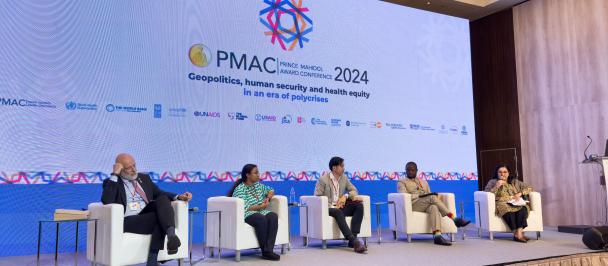A health worker pre-screens a man before administering a COVID-19 vaccine during the second phase of Bhutan’s national vaccine campaign. Photo: UNDP Bhutan.
In just one week, Bhutan successfully rolled out the second dose of its national COVID-19 vaccine campaign to more than 60 percent of its population, making this remote country the second most vaccinated in Asia, after Mongolia, and surpassing nearly all the countries in Europe and North America.
The success is largely credited to the exemplary COVID-19 response and recovery efforts by the government, under the guidance of His Majesty the King. A catalytic factor that also contributed to Bhutan’s successful and speedy second dose vaccination campaign was the development and use of the Bhutan Vaccine System (BVS).
The digital platform was developed by the country’s Ministry of Health with support from the UN Development Programme (UNDP).
“It is incredible to witness the speed at which Bhutan decisively moved forward with the digitization of the vaccine management system, in time for the COVID-19 vaccine roll-out,” said Azusa Kubota, UNDP Resident Representative in Bhutan. “Bhutan not only successfully vaccinated over 90 percent of its eligible population, but also took advantage of the pandemic to strengthen systems for future vaccine efforts. It is truly exemplary and inspiring.”
The vaccine system is part of a regional initiative on “Digital Solutions for the Delivery of COVID-19 Vaccines,” being rolled out in collaboration with WHO and UNICEF.
It has been critical in ensuring real-time data for an equitable, effective, safe and efficient roll-out of both doses, ensuring quick delivery and comprehensive coverage. UNDP also supported procurement of IT equipment for health workers and trained more than 2,100 health workers on how to register and screen patients, as well as follow-up on adverse events after immunization (AEFIs).
“The system overall has surpassed our expectations and we only hope to keep on using it in coming days,” said Garab Dorji, Chief ICT officer at the Ministry of Health. “This system has become one of the most important and sustainable systems for Bhutan now that COVID-19 vaccination certificates might become passports for travel.”
The key features of the digital vaccine system include monitoring stock, providing pre-registration, generating vaccination schedules, monitoring and tracking side effects following vaccination, as well as generating real-time reports and producing vaccine certificates.
The pre-registration allowed front line health workers to access beneficiary information on their laptops or cellular devices, without having to register data at the vaccination site – enabling quick and efficient delivery of the vaccines.
Damchoe Wangmo, in-charge at the Punakha hospital vaccination site where over 13,000 people were vaccinated, said that the BVS helped in smooth and efficient delivery of the vaccine. “We were not required to punch in data manually, and people did not have to wait in queue for registration,” she said, adding that they could also access information on a real time basis. “For example, if we wanted an age breakdown or the number of breastfeeding mothers that were vaccinated, we could simply put in the key words and search.”
During the second dose campaign, a total of 4,868 health workers and 2,161 DeSuung (Guardians of Peace) volunteers were involved at 1,217 vaccination posts.
Daksari Rai, 66 years old from Chukha said her son helped her register for the vaccine. “He said it is hassle free and easy to use. I feel confident that we can fight this pandemic.”
Although the primary use of the system will be for COVID-19 vaccination, it can for used for future campaigns, as well as routine vaccination programmes.
The data generated by the BVS is also expected to provide government valuable insights on decision making, on how best to support communities and where aid is most needed.
The first dose administered was AstraZeneca, which was donated by the Government of India. Vaccines for the second phase were procured through the COVAX facility under the leadership of His Majesty the King of Bhutan and a joint multilateral effort.
Bhutan received 500,000 doses of Moderna from the United States, 250,000 doses of AstraZeneca from Denmark, 100,000 doses of AstraZeneca from Croatia, Bulgaria and other countries, 50,000 doses of Sinopharm from People’s Republic of China, and 5,850 doses of Pfizer.
The donations illustrate global goodwill that can be fostered to ensure fairer and faster access to vaccines for all, to combat the pandemic.
In the drive for equitable access to the vaccine and to vaccinate as many people as possible in Bhutan, health care workers are now conducting home visits to vulnerable populations to administer the second dose.
Contact:
Kinley Wangmo, Programme Communications and Advocacy Analyst
kinley.wangmo@undp.org, +975 17342610

 Locations
Locations




